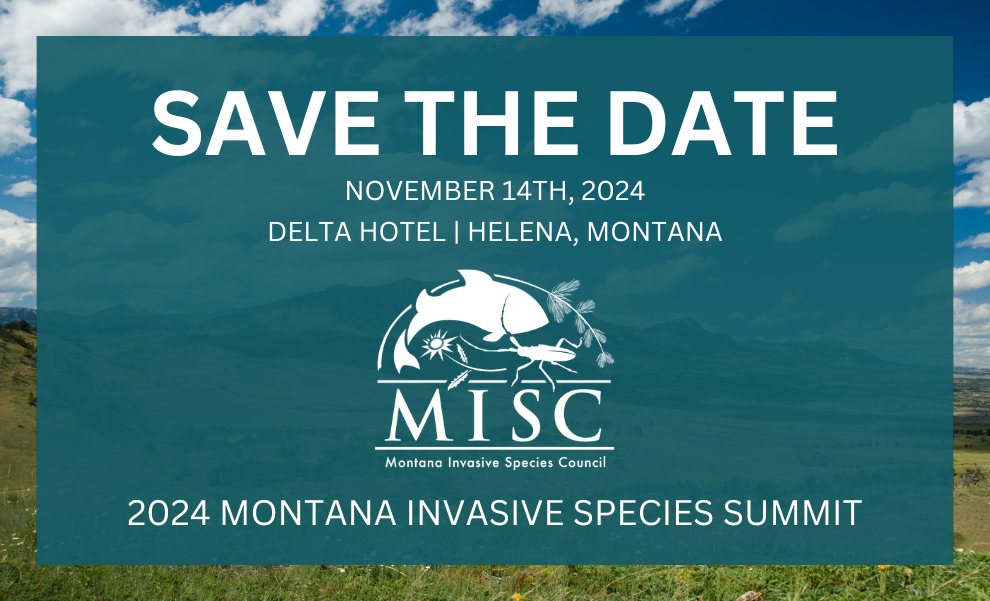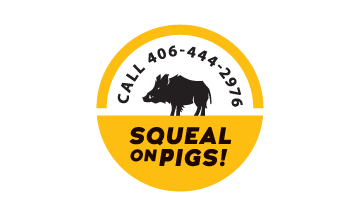|


Squeal on Pigs Hotline Working
In July, a tip was sent into the Squeal on Pigs Hotline that a wild boar was spotted running loose on the Fort Belknap Indian Reservation near Three Buttes, MT. However, after further investigation, it was determined the hog was a domestic pig which was captured and returned to its owner.
Northern News Network’s Cody Ross spoke with Montana State Veterinarian Tahnee Szymanski, DVM at the Montana Department of Livestock (DOL) who said the investigation was in coordination with USDA Wildlife Services and a local district investigator since the DOL does not have authority on the Fort Belknap Reservation. Continue reading...
More Feral Swine News
|
Mussles found on Moss Balls in Washington
OLYMPIA — On Monday, Aug. 5, the Washington Department of Fish and Wildlife (WDFW) received notification from a local wholesale aquarium company in Renton of possible invasive freshwater mussels on a shipment of Marimo moss balls (Aegagropila linnaei). Moss balls are a commonly used decorative algae in aquariums and water gardens. Read more...
Zebra Mussel Disposal Protocol
Owners of non-motorized watercraft in Utah required to train on quagga mussel prevention
SALT LAKE CITY — Before you launch your boat in Utah this summer, a new law requires you to take an online training course about the prevention of quagga mussels.
Lt. Bruce Johnson heads up the Aquatic Invasive Species Division at DWR. He said they’re working hard to keep quagga mussels from spreading. Continue reading...
Idaho implements new measures to combat invasive species
Boise, Idaho - The Idaho State Department of Agriculture (ISDA) announced that starting July 1, new laws will take effect to combat aquatic invasive species. Changes to law include mandatory inspection and decontamination for out of state watercraft, requirements for removing drain plugs and opportunities for local watercraft inspection stations.
“Since Idaho’s Legislature took action in 2008, our state has taken the forefront in combating aquatic invasive species,” said Chanel Tewalt, ISDA Director. “Today, Idaho adds additional tools in our fight to protect agriculture, power generation, recreation and private property.”
The new law directs that all out of state watercraft must be inspected and decontaminated at a watercraft inspection station prior to launch. Before launching a conveyance in Idaho, a nonresident watercraft owner must also purchase an invasive species sticker.
Before transporting any watercraft, operators must remove the drain plug and drain all water, including all internal compartments, such as ballasts, bilges, live wells and motors. All bilge and ballast plugs and other barriers that prevent water drainage from a conveyance must be removed and remain open while a watercraft is transported by land within the state. Continue reading...
Olympic windsurfers and rowers fighting invasive alien species
British windsurfers, sailors and rowers have been helping in the fight against invasive species – showing big sporting events like the Olympics can leave a legacy of biodiversity.
Pumping the sail to gain speed, windsurfer Alice Read lifts out of the water and glides across the sparkling blue of Portland Harbour. The only sounds are the wind and the quiet buzz of her hydrofoil. When she turns, I barely notice her crossing the board, her movements fluid as the water itself. She reaches for the surface with the fingertips of one hand, spray fizzing into the air as she swoops past. She is so close she could touch the boat I'm sitting in. Effortlessly, Read comes to a stop, resting for a moment to catch her breath. Continue reading...
The Clean.Drain.Dry. National Campaign on Invasive Species launch new website
Expect to Inspect.
More AIS News
|
|
Goldfish dumped in Giant Springs State Park
KRTV - In Giant Springs State Park, keen-eyed park visitors noticed two goldfish that had been illegally dumped swimming around in one of the creeks.
They recognized that these fish weren’t native to the area and quickly brought it to the attention of park managers. The managers were able to remove both fish, and rehome them safely. Continue reading...
Emerald ash borer detected in North Dakota
BISMARCK, N.D. – This week, adult emerald ash borers (EAB) were collected from a trap placed in LaMoure County, nine miles north of Edgeley, North Dakota. Upon follow-up from North Dakota Department of Agriculture (NDDA) staff, additional larvae were collected and have been officially confirmed as EAB. The detection is the first in North Dakota, and it becomes the 37th state to detect EAB.
“The North Dakota Department of Agriculture and our partners have been preparing for emerald ash borer’s eventual arrival for many years,” Agriculture Commissioner Doug Goehring said. “We have been placing and monitoring traps each summer and promoting awareness through outreach events, training and communication with the public. Now that it is unfortunately here, we urge North Dakota residents and travelers to be proactive to keep EAB from spreading.”
EAB is a wood boring insect originally from Asia, first found in the U.S. in 2002. It has since spread to 37 states and killed hundreds of millions of ash trees. Continue reading...
Are invasive spotted lanternflies hitching rides across state lines?
Some hitchhikers use their thumbs to catch a ride. Spotted lanternflies seem to do it with their spindly legs. According to a new study published today in Royal Society Open Science, these crop-destroying invasive insects can hang onto zooming vehicles and endure wind speeds up to 100 kilometers per hour. The finding could help explain how the spotted lanternfly, which was introduced to Pennsylvania in 2014, has spread so far and so fast in the United States within only a decade.
“Now we know that this is a big deal,” says Michael Wolfin, an insect behaviorist at Pennsylvania State University’s Department of Entomology who was not involved in the study. “We should be even more vigilant and make the public even more aware … to prevent their spread.”
Continue reading...
A spotted lantern fly on the headlight of a car | Jason Ondreicka/Alamy
|
|
North American Invasive Species Management Association Training Webinars
This program is designed to provide the education needed for professionals and students who are managing or learning to manage invasive species. The courses include the most current invasive species identification, control, and management techniques, and how to comply with local and federal regulations. Participants may register and enroll at any time, and will receive a certificate of invasive species management from NAISMA upon completion of the program. All live webinars are open to the public. Recorded webinars are available to members of NAISMA. NAISMA 2024 Webinar Schedule [cts.vresp.com]:
|
|
|
|
|